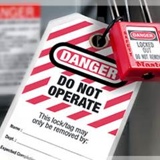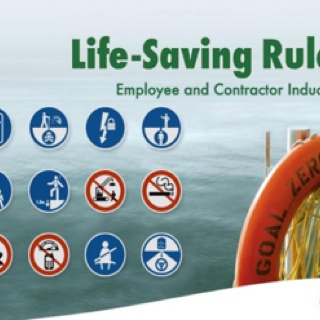Title Page
-
Site conducted
-
Conducted on
-
Prepared by
-
Location
Mandatory Audit questions
-
Mandatory audit questions based on 0600-000-030.01 ISE-PRO Isolation of Hazardous Energy Procedure
-
Do all electrical installations on site comply with Australian/NZ Standards (AS 3000 and 3012) and were/are they undertaken by licensed electricians?
6.1.1 Planning
-
Before a decision being made on the type of isolation most suitable for the hazardous energy source and the re-energisation process required, have the following factors should be taken into consideration:
-
- Identifying all energy sources, including uninterruptible power supplies.
-
- Identifying additional hazards associated with the isolation and re-energisation e.g., confined space entry, working at heights;
-
- Interaction between trades and any competing power requirements; and
-
- Identifying other personnel affected by the isolation and re-energisation.
6.1.2 Risk Assessment
-
Are all activities relating to isolation of hazardous energy identified, classified and risk assessed in accordance with 0000-050-030.01 RSK-PRO Risk Management and Hazard Identification Procedure prior to the work commencing?
6.1.3 Types of Isolation
-
Do single point isolations require each person working on the plant or equipment to indicate their presence by applying a tag and personal red danger lock to the energy isolation point before commencing work?
-
Is a multi-point isolation required when the equipment to be isolated:
-
- Has more than one isolation point.
-
- Has multiple energy sources.
-
- Involves High Voltage works.
-
- Requires limited energy availability while work is being carried out.
-
- Has a large (more than 6 permit workers) or diverse workgroup.
-
- Involves different contractors on a site.
-
- Requires isolation over extended shift periods; and
-
- Where determined as necessary (e.g., by the Permit Issuer or to comply with client requirements).
-
Does the multi-point isolation system include a team that has responsibility for the isolation including a responsible engineer, authorised isolator, permit acceptor and permit workers who plan, document, isolate and de-isolate and work under the permits?
-
Does the multi-point isolation system include a central coordinated multi-point isolation point (lockbox) which secures isolation locks and where persons, while working on the machinery or equipment, place their personal danger tag and red lock?
-
Where multi-point isolations are required, are isolation lists and drawings prepared clearly identifying each isolation point and the method for isolation?
6.1.4 Third-Party Isolation Processes
-
Where a third-party isolation process is required has an assessment been undertaken to ensure it meets the requirements of OMR 6?
-
(If these processes do not meet the requirements of OMR 6, or are deficient in other ways, then the workplace must implement the ACCIONA isolation procedure.)
-
Are external notification, authorization, and/or approval requirements associated with external party isolations identified during the planning stage with specific workplace processes developed to ensure any such requirements are known and complied with?
6.2.1 Isolation of Hazardous Energy Permit
-
Are isolation of hazardous energy permits required to be obtained/in place for the isolation and re-energization of energy sources?
-
The permit conditions must specify the test requirements for the presence of hazardous materials and stored energy.
-
Before raising a permit, do workers assess if the work is exempt from a permit and the type of isolation required (i.e., single point or multi-point)?
-
The Permit Issuer is required to confirm this assessment.
-
Are permits prepared, reviewed, and approved in accordance with 1300-020-030.01 PTW-PRO Permit to Work Procedure?
-
Are any other approved permits in use included in the relevant documentation pack kept with the isolation of hazardous energy permit in close proximity to the work activity?
-
Are exemptions for the need to complete a permit for single point isolations approved by the Project Manager? Only in cases where the isolation is relating to:
-
- Simple single point electrical isolations performed by licensed electricians; or
-
- Other tasks which have been risk assessed by a competent person, identified as low risk, and approved by the Project Manager.
6.2.2 Mobile Plant Isolation
-
Only competent persons familiar with the equipment undertake the isolation of mobile plant, and subsequently, the de-isolation of mobile plant following task completion. Isolation of mobile plant, operators must:
-
- Park equipment on level ground.
-
- Power plant components if possible (e.g., blade, bucket) or use rated support stands; and
-
- Chock equipment or apply other safe parking techniques to prevent movement.
-
For works performed by maintenance personnel involving isolation, are the maintenance manuals (provided by OEMs) available, and where applicable, procedures developed to meet manufacturer's specifications and recommendations?
6.2.3 De-energisation of Stored Energy
-
Where possible, are all stored energies de-energized?
-
Considering the following the steps:
-
- Relieve trapped pressure.
-
- Release the tension on springs, or block the movement of spring-driven parts.
-
- Block or brace parts that could move or fall.
-
- Bleed lines and leave vent valves open.
-
- Drain process piping systems and close valves to prevent the flow of hazardous material; and
-
- Purge process lines, remove links, air gap, etc.
6.2.4 Test for Dead
-
Prior to work being conducted on plant and/or equipment, was a competent person appointed as the authorised isolator that confirms the isolation has been successful by conducting a test for dead. A test for dead may include: Physical separation. Releasing stored energy. Conducting Voltage Checks (Meters shall be tested on a known live source, then test for dead then confirm on live source). Inspecting Phase indication lights (ON-OFF). Releasing of pressure in a controlled manner; or Chocking, pinning or supporting to prevent movement.
-
Is testing at Low Voltage only performed live when that work is performed by licensed electrical workers and the following requirements are met: Test equipment that is suitable for its intended purpose and confirm correct operation, particularly after extended periods of storage, to ensure that it remains operational and safe. Confirm the selected test equipment is correctly set, functional and in good condition before any testing commences. Check against a range of resistors or known values or other calibration checks to confirm operation as appropriate. Inspect the selected test equipment to ensure it has a current calibration certificate. Check contact probes and leads for damage to insulated parts, continuity and sound connections before each use.
-
Does testing equipment exposed to high fault currents include Type A probes (leads)?
-
Does each person in the workgroup fix their red Personal Danger Lock and Tag to the isolation point (single point isolation) or designated lock box (multi-point isolation) as indicated by the Isolation Permit.
6.2.5 Personal Danger Tags and Locks
-
Are red Personal Danger Lock and Tag only placed and removed by the person whose name appears on the tag?
-
Is each red Personal Danger Lock uniquely (and very clearly) labelled and keyed?
-
Prior to attaching a red Personal Danger Lock and Tag, are permit Workers required to: a. Personally, verify that the Isolation Point is appropriate for the work scope
-
Prior to attaching a red Personal Danger Lock and Tag, are permit Workers required to: Confirm their agreement to work on the isolation by signing the Isolation of Hazardous Energy Permit.
6.2.6 Isolation Removal (Re-energisation)
-
Are lock-out devices only removed under the conditions that the authorised isolator has determined that it is safe to de-isolate?
-
The authorised isolator has determined that it is safe to de-isolate by: -Ensuring the installation, plant or equipment is safe to re-energise. Notifying all relevant persons that the installation, plant or equipment is about to be re-energized. Completing a visual inspection to determine that all tools, surplus materials and wastes have been removed.
6.2.7 Change of Shift/Handover
-
For personal isolation where the work is not completed by the end of the shift, or work stops for an extended period, are all personal locks and danger tags removed, and a general lock placed on the isolation point with an out of service tag? The out of service tag should state clearly the condition of the equipment.
-
The out of service tag should state clearly the condition of the equipment.
-
For a group isolation where the work is not completed by the end of the shift and handover is immediate, does the incoming permit acceptor inspect and verify the isolations?
-
Change of Shift/ Handover- Does the incoming permit acceptor, authorised isolator and permit workers immediately place their lock on the lock box when the outgoing permit acceptor, authorised isolator and permit workers remove theirs?
-
Where work is not completed and there is no handover, the permit holder replaces their lock with a general lock and an out of service tag. The out of service tag must state the condition of the equipment.
6.2.8 Emergency Planning
-
Are electrical emergencies assessed, tested for effectiveness and managed in accordance with relevant project specific emergency management plans and 0000-101-030.01 EMG-PRO - Emergency Critical Response Procedure?
-
Are emergency plans developed when performing isolation of hazardous energy sources and taking the following into consideration: The nature of the work being carried out; The nature of the hazards; The size and location of the workplace; The rescue equipment required; and The number and composition of the workers and other people at the workplace.
-
Before commencing work, are the contents of rescue kits checked to ensure they are in good condition and are suitable for the work situation, including the due date for tests being checked to ensure currency?
-
Where a device is used for isolating, dissipating or restraining energy on plant, is it locked by a competent person in conjunction with the Isolation permit?
-
Are devices that incorporate a lock or can accommodate one or more padlocks only used to lock out an item?
-
Such devices include: Switches with built-in locking points; Lock-out circuit breakers; Lockable fuse and valve handle covers; and Lock-out jaws (also known as hasps) and safety padlocks.
6.3.1 Lockout Devices
-
When isolating an energy source for group isolation, is a device that allows one or more padlocks used?
-
If more than one person is working on the same plant, each person must attach their personal lock to prevent the isolator being opened before all locks have been removed or opened.
-
Where a lock is used as an isolation device, is a tag also incorporated to explain the purpose of the lockout?
-
Are Danger Tags affixed by the person(s) required to work on the equipment / system?
-
Are Danger Tags only removed by the person who affixes the tag?
-
Are 'Out of Service" Tags only removed by the service operative or specific operator?
6.3.3 Lost Key or Damaged Lock
-
Are Permit Workers required to advise the Permit Acceptor and/or Supervisor if the key to a personal lock is lost or the lock cannot be opened? The Permit worker can then remove the lock and tag in the presence of the Supervisor and Permit Acceptor.
-
The Permit worker can then remove the lock and tag in the presence of the Supervisor and Permit Acceptor.
6.3.4 Missing Person from Site
-
Where there is a Person Missing from site- Does the Supervisor attempt to contact the missing Permit Worker?
-
Where there is a Person Missing from site and the Supervisor has made contact with them, and the worker can return to site, are they required to, to remove the lock & tag and sign off of the Isolation permit?
-
Where there is a Person Missing from site and is uncontactable or unable to return to site, are their lock/s and tag/s only removed following authorisation by the Project Manager?
-
Authorisation by the Project Manager must be supported by: Authorisation by the project Manager must be supported by:
• There is a need to remove the lock and tag, and
• Every precaution has been taken to ensure that it is safe to do so, and
• Any other conditions associated with the removal (disciplinary action, follow ups). -
Where there is a Person missing from site and their lock & tag has been removed, and the equipment cannot be returned to service, does the Supervisor place a yellow Out of Service tag on the equipment?
6.4.1 Competency and Training
-
Do workers involved in work related to the isolation of hazardous energy hold the relevant licenses/qualifications and training as detailed in the National Training Matrix?
-
Are isolations of hazardous energy sources only conducted by a person deemed competent?
-
Are competency requirements assessed based on knowledge, experience and/or trade-based qualifications that the person possesses prior to performing work?
6.4.2 Consultation
-
Are all people involved in an allocated task:
-
Consulted by the Supervisor on the specific task hazards, as well as surrounding hazards during a pre-start meeting at the task location;
-
Briefed on the task SWMS, fully understand the SWMS, and have an opportunity to discuss items specific to their role within this task; and
-
Briefed and understand the emergency response arrangements in place.
6.4.3 Monitoring
-
-
Are inspections conducted throughout the course of the activity being performed to ensure that preventive risk controls are implemented and processes to minimize risk exposure remain effective in accordance with 0000-120-030.01 MME-PRO Monitoring, Measurement and Evaluation and recorded via the Lucidity inform module?










